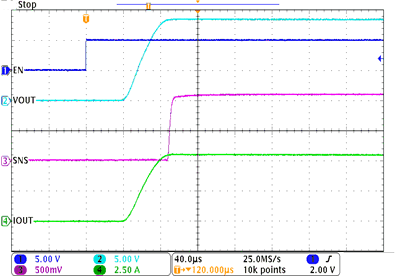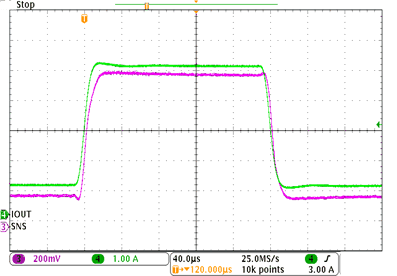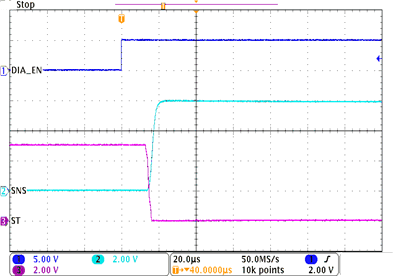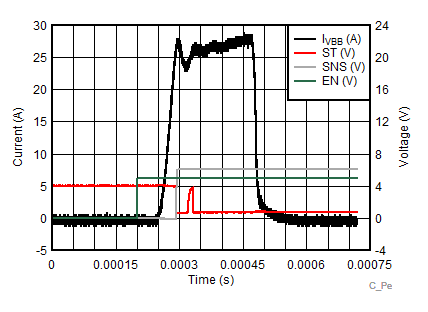SLVSDM4D November 2018 – December 2019 TPS1HA08-Q1
PRODUCTION DATA.
- 1 Features
- 2 Applications
- 3 Description
- 4 Revision History
- 5 Device Comparison Table
- 6 Pin Configuration and Functions
- 7 Specifications
- 8 Parameter Measurement Information
-
9 Detailed Description
- 9.1 Overview
- 9.2 Functional Block Diagram
- 9.3
Feature Description
- 9.3.1 Protection Mechanisms
- 9.3.2 Diagnostic Mechanisms
- 9.3.3 Enable Watchdog
- 9.4 Device Functional Modes
- 10Application and Implementation
- 11Power Supply Recommendations
- 12Layout
- 13Device and Documentation Support
- 14Mechanical, Packaging, and Orderable Information
Package Options
Mechanical Data (Package|Pins)
- PWP|16
Thermal pad, mechanical data (Package|Pins)
- PWP|16
Orderable Information
10.2.3 Application Curves
Figure 57 shows the behavior of the in this application when the MCU provides an enable pulse to beginning heating the resistive element. Shortly after the EN pin goes high, the load current begins to flow and the SNS pin measures the output current.
 Figure 57. Heater Turn-on Time
Figure 57. Heater Turn-on Time By measuring the voltage on the SNS pin, the can communicate back to the system MCU what the load current is. Figure 58 shows that when the seat heater approaches full load and IOUT jumps from a low load current of 1 A up to a 5 A load current, the load step is mirrored on the SNS pin.
 Figure 58. SNS Response During Heater Load Step
Figure 58. SNS Response During Heater Load Step One common concern in these type of applications is that the heating element can accidentally lose connection, creating an open load situation. In this case, it is ideal for the to recognize that the load has been removed and report a FLT to the MCU. Figure 59 shows the behavior of the when there is no load attached. As soon as the DIAG_EN pin is engaged, the SNS output goes high and the ST output engages low. By monitoring these pins, the MCU can recognize there is a fault and notify the user that maintenance is required.
 Figure 59. Open Load Detection If Heating Element is Missing
Figure 59. Open Load Detection If Heating Element is Missing Importantly, the will also protect the system in the event of a short-circuit. Figure 60 shows the behavior of the device if it is enabled into a short circuit condition. If this is using the device option C, the current will be clamped to the current limit ICL until it hits an over temperature event, at which point it will shut down. In this way, the system is protected from unchecked overcurrent in the event of a short circuit.
 Figure 60. Overcurrent Behavior During Short Circuit Event
Figure 60. Overcurrent Behavior During Short Circuit Event